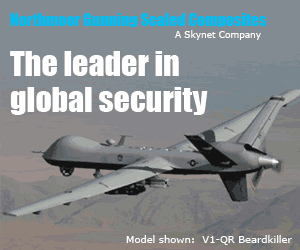by Flint Driscoll on April 15th, 2011
Speaking of the Toploader Project, Deathorfreedom61 asks whether I have any more hard details about the drone technology used by the terrorists to control and detonate their bomb-donkeys. Indeed I do, deathorfreedom61, and thanks for asking.
My old friend wonderboom41, with whom I have broken a lance or two over the years at the TerrorWatch moderated forum, has helped by providing me with the inside line on recent developments at the more hard-edged end of the tech-savvy security chat room spectrum.
Cross-referencing with certain chatter picked up by the NSA on twitter and “declassified” by wikileaks (I know, I know), it’s clear that coldwarbaby65 was correct when he concluded his masterful analysis of the topic at honestblogging.com by referencing lalaliberal’s confirmation that all known facts support my own hypothesis that, as certain highly-placed military sources told me on my last visit to the Embargoed Zone, simple logic demonstrates that the terrorists are now beyond doubt controlling the exploding donkeys using top-secret wire-guided neuro-electronic synapse mind-meld technology stolen by the Revolutionary Guard from secret US Navy bomb-dolphin field tests in the Shatt-al-Arab and then smuggled out to client death squads in various terrorist enclaves around the world, including the Embargoed Zone, Statten Island, Bexhill and Clondalkin.
For further proof, check out these recent exchanges from my own message board, which I’ve collated and redacted here. Also, follow me on twitter at @flintdriscoll. You guys can handle this stuff. The bad guys can’t.
Posted in Drones, Embargoed Zone
Leave a Comment
by Flint Driscoll on April 22nd, 2011
I have mixed feelings about the news that Barack Hussein Obama has finally authorized the deployment of killer robots to Libya. On the one hand, I have always been a major supporter of the expanded use of attack drones in modern warfare, and no one has greater admiration than I for the brave young men and women who operate these vital weapons of freedom. But why has Barack Hussein Obama left it so late? And will he go in hard enough? Each Predator drone (and I have reason to believe that we have even more potent shots in our locker) is able to deploy pin-point Hellfire missiles, right down the terrorists’ throats. More importantly, it can serve as an “eye in the sky”, identifying and designating targets for US aircraft (why oh why do we persist with this NATO farce?) which can then bomb from high altitude and at supersonic speed, protected, if need be, by Wild Weasel assets deploying HARM weapons against terrorist air defences. Nothing shouts justice like a one ton smart bomb.
But will the present administration have the guts to go the extra mile against Gaddaffi and his sub-Saharan henchmen? Frankly, I doubt it. And so do you.
Posted in Drones
Leave a Comment
by Flint Driscoll on June 14th, 2011
Until now I have resisted the mounting pressure for me to comment on the situation in Syria. I must admit that I have struggled to find a way to explain this highly complex problem in terms that you, the layman (and who knows, perhaps laylady) might understand. It is not sufficient to say, as we do of our Facebook relationship statii, that “it’s complicated”.
Fortunately, I have come up with an analogy that will serve to expose the anatomy of the crisis in terms that even a simpleton could not fail to understand.
I speak of the analogy of Schrödinger’s Cat. As everyone knows, Schrödinger was a physicist who dabbled on the side in veterinary science. He found that by locking a cat into a sealed, airless box for a defined period of time, he was able to induce in it a state of profound coma. The cat, in other words, was at once dead and alive, occupying two contradictory states at the same time. Even more remarkably, Schrödinger was able to demonstrate that the mere act of observing the cat’s state had the effect of changing that state. If he opened the box to observe the cat after, say, one minute, he found it to be in a highly agitated state. If he waited ten minutes, on the other hand, he would observe the cat to occupy a state of absolute inertia.
I simplify, of course, for your benefit: there is a lot of highly complex mathematics involved that need not trouble you. My point is this: 1. It is possible for a person to be two entirely contradictory things at the same time. And 2. It just depends how you look at things.
The person in question today is President Bashar al-Assad, Syria’s youthful dictator. I have never been to Syria – no doubt I am on a watch list at the airport, and then there’s the whole kidnapping risk, and the dangers of drinking non-domestic bottled water – but I have been blogging about the middle east for many years now, and few people outside the Center for Security Policy can have such a deep understanding and compassionate concern for the human tragedy now unfolding there.

Bashar al-Assad: Cat in a hot tin box
Because President Bashar al-Assad is a deeply tragic, conflicted figure. On the one hand he – like his father Hafez before him – is the leader of a corrupt and brutal minority regime, dependent for its survival on malign foreign interlopers: first, the Soviet empire; now, the fanatical, nuclear-armed ayatollahs of Iran, and their proxy Shia henchmen in Lebanon’s genocidal Hizbollah terror group. Together, they pose an existential threat to the very existence of America’s closest and dearest ally, plucky little Israel, which could at any moment be overrun by Syria’s massed tank legions, or incinerated by an Iranian first strike. Damascus also gives shelter to the exiled leadership of the Palestinian terror group Hamas, which continues to resist Israeli rule despite all that Israel has done for its Arab immigrant population. Which is just plain nasty, if you ask me.
But seen another way, Bashar is a decent, reluctant leader, summoned to the throne only after his elder brother died in a car crash. A self-declared reformist, he has, like his father, proved very sporting down the years about Israel’s rightful annexation of the Golan Heights, dashingly seized from Syria in a defensive proactive surprise attack in 1967. While he still complains about the Golan in public, Assad has in practice let things slide. Moreover, as a minority Alawite, allied to Syria’s other minorities – Christians, Shiites, Alevis, whatever you’re having yourself – Assad is a stout bulwark in defense of religious tolerance; a stern but fair ruler who resists the machinations of Syria’s lumpen Sunni Muslim majority.
Without Assad, our strategic position in the region would be gravely weakened: the Sunnis must never be allowed to take over in Syria, as they have already done, disastrously, in Turkey. Israel is, and must remain, the only democracy in the middle east. Because democracies are hard for us to bomb.
So what can we in the US do to resolve this contradiction? Do we back Assad, or bomb him? The answer, naturally, is to do both. I haven’t quite worked out the details yet, but I know from my extensive on-line research – I hate that term, “drone porn” – that we in the US (and Israel, of course) now have weapons so precise that we can use them to micromanage any local or global problem.
I shall tweet my friend Henry, who does publicity work for the Skynet Corporation, to dig up some more specifics on the latest drone warfare capability upgrades, but in the meantime let me sketch out a possible scenario: Bashar al-Assad throws open the French windows of his presidential palace, high on a hillside overlooking Damascus, and squints westwards towards Israel’s Golan Heights. He sets out across the lawn towards them, and instantly a small, non-explosive kinetic anti-tank missile, fired from a circling drone, crashes into the ground at his feet. Thinking better of his chosen path, he turns to the east. Wrong again: thither lies Iran. Another missile firmly but unmistakably interdicts his path. Where can he go next? South, to invade loyal little moderate Jordan, as his father once tried? Wham! Another missile at his feet. Dance, Bashar, dance! It won’t take long before he gets the message, and knuckles down to fighting Islamic extremism for us, in Jisr al-Shughour, and Deraa, and Homs.
Posted in Drones, International
1 Comment









